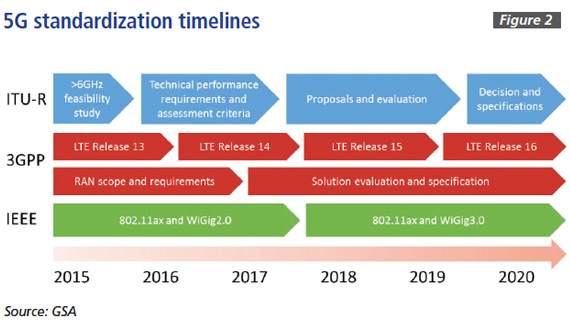Spectrum issues
One of the hottest issues surrounding 5G is, of course, spectrum: not just the amount required but where to get it. According to another ITU report (ITU-R M.2376), “utilizing the bands between 6 and 100 GHz is feasible for studied IMT deployment scenarios, and could be considered for the development of IMT for 2020 and beyond.” And indeed, a lot of research at the moment is already looking at ways to use the higher-frequency millimeter-wave bands as spectrum resources for 5G.
For now, however, most available frequencies for mobile operators are in the sub-6GHz range. After last November’s WRC-15 conference, the GSM Association was able to secure harmonized bands for 700 MHz (specifically, 694-790 MHz) the lower 200 MHz of the C-band (3.4-3.6 GHz) and L-band (1427-1518 MHz). But new frequency allocations above 6 GHz weren’t on the table, and are not likely to be forthcoming until at least WRC-19, where millimeter-wave bands above 24 GHz will be on the docket.
When can we call it 5G?
Even so, no one’s going to wait around until WRC-19 to get cracking on 5G deployments. Many operators are already heading down that pathway by deploying many of the core elements of 5G, such as IoT platforms, NFV, carrier-grade Wi-Fi and carrier aggregation for LTE-A, to name a few. It’s early days, but the foundations for 5G are already being laid, even if most operators aren’t thinking of it as 5G. Meanwhile, there are already a handful of cellcos actively committed to 5G roadmaps and trials. In Asia, that includes all of the Korean operators (KT, LG U+, and SK Telecom), China Mobile, NTT DoCoMo, Singtel, Softbank, Telstra, and Vodafone Australia.
Perhaps inevitably, there is already some debate about just how many parameters an operator should achieve before they can officially declare their network or service “5G”.

This is partly because the above ITU parameters are guidelines, not hard rules. Official 5G standards won’t be ready for a few years, and the standards bodies working on them - including the ITU, the 3GPP and the IEEE, all have overlapping timelines (see Figure 2, above).
Also, 5G technologies won’t be rolled out uniformly or even everywhere. Legacy 3G and 4G will still exist, and 4G will continue to evolve, possibly to the point where it can actually meet some 5G performance criteria on its own. By 2020, many initial 5G rollouts will be highly targeted and limited to specific areas and apps.
As for when it starts counting as 5G, it depends who you ask. A November 2015 survey from the GSA provided operators, vendors, regulators, analysts and consultants with a list of 5G parameter performance benchmarks and asked how many of them operators would have to meet to credibly brand the network 5G. Over 40% of operators said all criteria would have to be met, but some said “a few,” while a small percentage said just one benchmark would do. Vendors were considerably more lax in their assessments of what would count as 5G, with close to 25% saying just a few benchmarks would have to be met.
(For the record, the GSA’s stance is that in order to qualify as “5G”, the two defining network characteristics would be a new air interface alongside the legacy ones, and sophisticated network slicing capabilities via SDN and NFV that intelligently match resources to applications).
The GSA’s forecast for 5G rollouts takes this into account. Accordingly, the GSA says we’ll only see between ten and 15 “early 5G” commercial launches - in other words, 5G offerings that meet some but not all benchmark criteria.
The industry group predicts that commercial deployment will begin in earnest after the standardization process is completed in 2020, with over 270 operators having introduced commercial 5G services by 2025. However, the report says, “this does not mean those networks will be extensive.”
The GSA expects coverage to likely be initially limited to dense urban areas, with cellcos “using whatever frequencies, modes and technologies make sense to an individual operator in any given location in order to deliver indoor and outdoor coverage - but in particular in hot spot locations where capacity starts to run out. We do not anticipate many widespread 5G network deployments within the forecast period.”
This article was first published in Telecom Asia 5G Insights February 2016 edition
